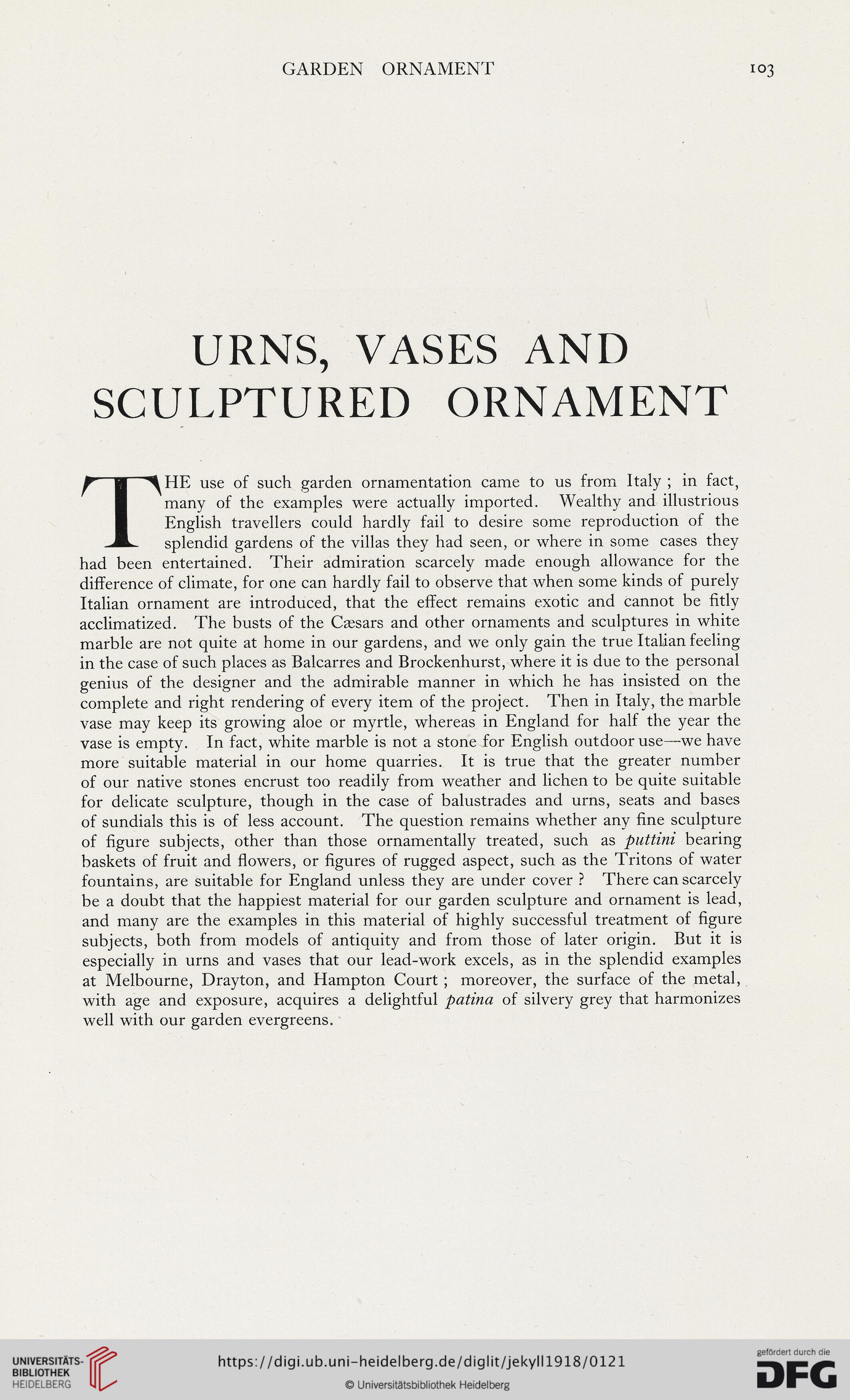GARDEN ORNAMENT
103
URNS, VASES AND
SCULPTURED ORNAMENT
THE use of such garden ornamentation came to us from Italy ; in fact,
many of the examples were actually imported. Wealthy and illustrious
English travellers could hardly fail to desire some reproduction of the
splendid gardens of the villas they had seen, or where in some cases they
had been entertained. Their admiration scarcely made enough allowance for the
difference of climate, for one can hardly fail to observe that when some kinds of purely
Italian ornament are introduced, that the effect remains exotic and cannot be fitly
acclimatized. The busts of the Caesars and other ornaments and sculptures in white
marble are not quite at home in our gardens, and we only gain the true Italian feeling
in the case of such places as Balcarres and Brockenhurst, where it is due to the personal
genius of the designer and the admirable manner in which he has insisted on the
complete and right rendering of every item of the project. Then in Italy, the marble
vase may keep its growing aloe or myrtle, whereas in England sor half the year the
vase is empty. In fact, white marble is not a stone for English outdoor use—we have
more suitable material in our home quarries. It is true that the greater number
of our native stones encrust too readily from weather and lichen to be quite suitable
for delicate sculpture, though in the case of balustrades and urns, seats and bases
of sundials this is of less account. The question remains whether any fine sculpture
of figure subjects, other than those ornamentally treated, such as puttini bearing
baskets of fruit and ssowers, or figures of rugged aspect, such as the Tritons of water
fountains, are suitable for England unless they are under cover ? There can scarcely
be a doubt that the happiest material for our garden sculpture and ornament is lead,
and many are the examples in this material of highly successful treatment of figure
subjects, both from models of antiquity and from those of later origin. But it is
especially in urns and vases that our lead-work excels, as in the splendid examples
at Melbourne, Drayton, and Hampton Court ; moreover, the surface of the metal,
with age and exposure, acquires a delightful patina of silvery grey that harmonizes
well with our garden evergreens.
103
URNS, VASES AND
SCULPTURED ORNAMENT
THE use of such garden ornamentation came to us from Italy ; in fact,
many of the examples were actually imported. Wealthy and illustrious
English travellers could hardly fail to desire some reproduction of the
splendid gardens of the villas they had seen, or where in some cases they
had been entertained. Their admiration scarcely made enough allowance for the
difference of climate, for one can hardly fail to observe that when some kinds of purely
Italian ornament are introduced, that the effect remains exotic and cannot be fitly
acclimatized. The busts of the Caesars and other ornaments and sculptures in white
marble are not quite at home in our gardens, and we only gain the true Italian feeling
in the case of such places as Balcarres and Brockenhurst, where it is due to the personal
genius of the designer and the admirable manner in which he has insisted on the
complete and right rendering of every item of the project. Then in Italy, the marble
vase may keep its growing aloe or myrtle, whereas in England sor half the year the
vase is empty. In fact, white marble is not a stone for English outdoor use—we have
more suitable material in our home quarries. It is true that the greater number
of our native stones encrust too readily from weather and lichen to be quite suitable
for delicate sculpture, though in the case of balustrades and urns, seats and bases
of sundials this is of less account. The question remains whether any fine sculpture
of figure subjects, other than those ornamentally treated, such as puttini bearing
baskets of fruit and ssowers, or figures of rugged aspect, such as the Tritons of water
fountains, are suitable for England unless they are under cover ? There can scarcely
be a doubt that the happiest material for our garden sculpture and ornament is lead,
and many are the examples in this material of highly successful treatment of figure
subjects, both from models of antiquity and from those of later origin. But it is
especially in urns and vases that our lead-work excels, as in the splendid examples
at Melbourne, Drayton, and Hampton Court ; moreover, the surface of the metal,
with age and exposure, acquires a delightful patina of silvery grey that harmonizes
well with our garden evergreens.




